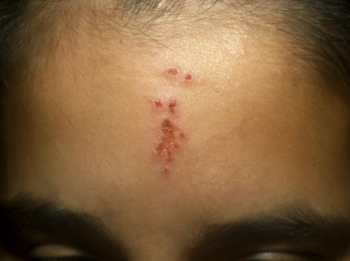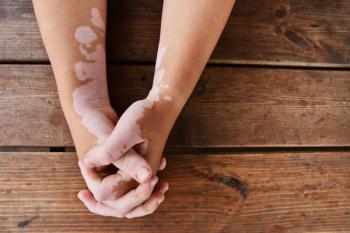
- Consultant for Pediatricians Vol 9 No 10
- Volume 9
- Issue 10
Juvenile Dermatomyositis Sine Myositis
This 8-year-old girl has had swollen, red eyelids for the past 24 hours. She denies pain or pruritus. She has had no eye drainage, fever, or other systemic signs of illness. She reports some mild fatigue for the past few months but denies myalgias or decreased muscle strength.
This 8-year-old girl has had swollen, red eyelids for the past 24 hours. She denies pain or pruritus. She has had no eye drainage, fever, or other systemic signs of illness. She reports some mild fatigue for the past few months but denies myalgias or decreased muscle strength. Her medical history includes type 1 diabetes mellitus diagnosed at 3 years of age. The child is afebrile on examination. She has full range of motion of the eyes, no scleral injection, and normal pupillary reflexes. Muscle strength is normal in all extremities; no abnormalities of the hands or fingers are apparent.
Answer: Heliotropic rash consistent with juvenile dermatomyositis sine myositis.
Juvenile dermatomyositis is a rare autoimmune vasculitis in children. Although the pathogenesis is still unclear, a genetic susceptibility to acquiring the disease among first-degree relatives and an association with other autoimmune diseases have been noted. Affected children often present with symmetrical proximal muscle weakness, weight loss, fever, fatigue, and anorexia, or they may present with one or both of the classic rashes of the disease.1 The heliotropic rash-the presenting symptom in this child-is a violaceous flat rash of the eyelids, sometimes with malar involvement, that is often accompanied by periorbital edema. The other characteristic rash, Gottron sign, is an erythematous eruption over the dorsum of the knuckles.
Poll Results
Poll Software
Powered By
WebsiteGear
: Requires Javascript Enabled On Your Browser.
Dermatomyositis sine myositis is a term used to describe patients who present with the dermatological features of dermatomyositis but an absence of associated muscle findings. It is not uncommon for children to present with cutaneous findings before the onset of muscle involvement. Sometimes the presentation of the dermatological features of the disease can precede the muscle features by months to years.2
Complications of dermatomyositis include contractures, GI vasculopathy, and calcinosis. Treatment includes immunosuppression and physical therapy. For patients with the heliotropic rash, which is photosensitive, the judicious use of sunscreen is advised.3
Articles in this issue
about 15 years ago
Snippets of Vaccine History: Success, Failure, and Controversyabout 15 years ago
Should the Topic of Thimerosal-Free Vaccines Be Discussed With Parents?about 15 years ago
Importance of Immunization: A Serious Disease Is Just a Plane Ride Awayabout 15 years ago
Children With Gigantism, Hypotonia, and an Unusual Facial Appearanceabout 15 years ago
Shin Guard Dermatitisabout 15 years ago
Pompholyxabout 15 years ago
Orbital Cellulitisabout 15 years ago
To Tie or Not to Tie: The Dilemma of the Supernumerary Digitabout 15 years ago
Keratosis pilaris: Regimens for rough skinNewsletter
Access practical, evidence-based guidance to support better care for our youngest patients. Join our email list for the latest clinical updates.











